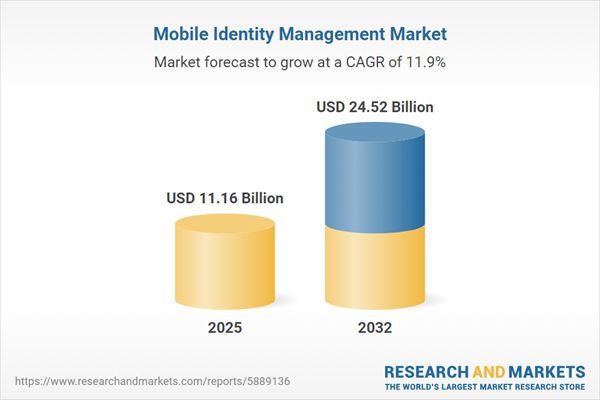Speak directly to the analyst to clarify any post sales queries you may have.
Mobile identity management has become essential for enterprises as rapid digital transformation redefines secure access and compliance. Senior leaders recognize the need for integrated strategies to protect workforces, support flexible operations, and ensure regulatory alignment in complex, evolving digital landscapes.
Market Snapshot: Mobile Identity Management Market Growth and Dynamics
The global mobile identity management market is expanding at a steady pace, valued at USD 10 billion in 2024 and forecasted to reach USD 11.16 billion in 2025, reflecting a compound annual growth rate (CAGR) of 11.86%. Long-term projections indicate momentum will continue, with the market anticipated to grow significantly by 2032. This positive trajectory is driven by increasing reliance on mobile devices in enterprise environments, the widespread shift toward remote and hybrid working models, and the significant influence of evolving privacy regulations. Organizations place greater emphasis on seamless integration and adaptive authentication measures to enhance operational agility and meet higher security and compliance demands in diverse digital ecosystems. The growing complexity of global regulations is contributing to rising demand for flexible identity management solutions that can be tailored to specific regions and sectoral compliance requirements.
Scope & Segmentation of the Mobile Identity Management Market
This report provides actionable insight for senior decision-makers, highlighting the critical role of mobile identity management in supporting compliance, security, and operational resilience worldwide. The analysis examines how organizations select and refine identity strategies by segment:
- Organization Size: Large enterprises, midsize organizations, and small businesses face distinct identity management challenges and must balance deployment requirements with compliance expectations.
- Component: Solutions cover both hardware and software, supported by dedicated services that optimize integration and user uptake.
- Deployment Mode: Deployment options include public, private, hybrid, and community clouds, as well as on-premises environments; choices reflect local data protection laws and organizational security policies.
- Authentication Method: Technology spans biometrics, certificates, passcodes, and push notifications, providing varying degrees of security and user experience based on business risk tolerance.
- Industry Vertical: Finance, healthcare, government, defense, IT, telecom, retail, and ecommerce each require tailored solutions to address sector-specific compliance mandates and operational workflows.
- Regional Coverage: North America, Latin America, Europe, the Middle East, Africa, and Asia-Pacific all present unique market dynamics, regulatory frameworks, and technology adoption rates influencing identity strategies.
- Key Companies: Industry leaders—including Microsoft, Okta, Cisco, Ping Identity, IBM, SailPoint, ForgeRock, CyberArk, RSA Security, and SecureAuth—shape standards and best practices for identity management globally.
Key Takeaways for Senior Decision-Makers
- Adaptive authentication enables secure and flexible access for distributed teams, supporting continuity and resilience.
- Cloud-based and artificial intelligence-powered tools allow rapid response to evolving threats while maintaining regulatory alignment.
- Enterprises benefit from modular and flexible deployment options, matching privacy controls to budget constraints and future scalability needs.
- Heavily regulated industries require advanced device validation and governance, while less regulated sectors can streamline implementations and accelerate integration with legacy systems.
- Strong collaboration between identity vendors, device manufacturers, and cloud service providers is a key factor in developing robust end-to-end security architectures and compliance assurance.
Tariff Impact: Navigating Regulatory and Economic Changes
Planned US tariffs targeting mobile devices and biometric equipment are altering procurement and supplier decisions for enterprises in the near term. Organizations are broadening their supplier base and increasing their use of software-driven identity management to decrease vulnerability to supply chain disruptions. Strategic supplier diversification and adaptive integration frameworks have become core priorities as the regulatory environment grows more complex.
Methodology & Data Sources
This analysis combines direct interviews with IT executives, feedback from channel partners, and a review of established industry research. Forecasts are developed using expert-led modeling and validated by thorough secondary research, guaranteeing data reliability.
Why This Report Matters
- Guides senior leaders in evolving mobile identity management strategies to address shifting global security and compliance priorities.
- Supports smarter technology investments and partnership decisions amid changing regulatory and economic pressures.
- Clarifies essential integration and security practices for developing resilient identity frameworks across multiple business sectors.
Conclusion
Investing in modern mobile identity management equips organizations to meet operational and regulatory demands effectively. Strategic adoption fosters digital resilience and a strong foundation for secure transformation initiatives.
Additional Product Information:
- Purchase of this report includes 1 year online access with quarterly updates.
- This report can be updated on request. Please contact our Customer Experience team using the Ask a Question widget on our website.
Table of Contents
3. Executive Summary
4. Market Overview
7. Cumulative Impact of Artificial Intelligence 2025
Companies Mentioned
The companies profiled in this Mobile Identity Management market report include:- Microsoft Corporation
- Okta, Inc.
- Cisco Systems, Inc.
- Ping Identity Corporation
- IBM Corporation
- SailPoint Technologies Holdings, Inc.
- ForgeRock, Inc.
- CyberArk Software Ltd.
- RSA Security LLC
- SecureAuth Corporation
Table Information
| Report Attribute | Details |
|---|---|
| No. of Pages | 182 |
| Published | October 2025 |
| Forecast Period | 2025 - 2032 |
| Estimated Market Value ( USD | $ 11.16 Billion |
| Forecasted Market Value ( USD | $ 24.52 Billion |
| Compound Annual Growth Rate | 11.8% |
| Regions Covered | Global |
| No. of Companies Mentioned | 11 |









